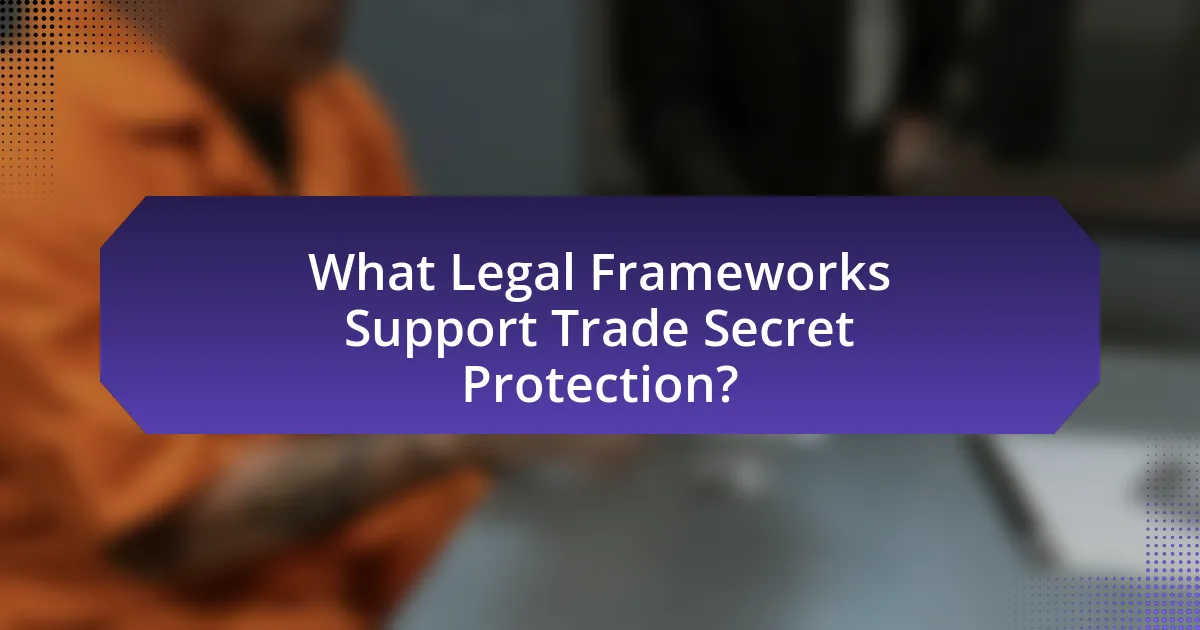Trade secrets are confidential business information that provide a competitive advantage, encompassing formulas, processes, and proprietary knowledge. The article outlines the legal definitions and criteria for trade secrets, emphasizing the importance of confidentiality in protecting these assets from unauthorized disclosure. It discusses the risks associated with failing to maintain trade secret confidentiality, including financial losses and legal liabilities, and highlights best practices for safeguarding trade secrets, such as implementing security measures, conducting employee training, and adhering to legal frameworks like the Uniform Trade Secrets Act and the Defend Trade Secrets Act. Additionally, the article addresses the challenges businesses face in protecting trade secrets, particularly in the context of remote work and employee turnover, and offers strategies for effectively managing and updating trade secret protections.

What are Trade Secrets and Why is Confidentiality Important?
Trade secrets are confidential business information that provides a competitive edge, such as formulas, practices, processes, designs, or any proprietary knowledge. Confidentiality is crucial because it protects these secrets from being disclosed to competitors, which could undermine a company’s market position and profitability. For instance, the Coca-Cola formula is a well-known trade secret that has been safeguarded for over a century, demonstrating the value of maintaining confidentiality to preserve competitive advantage.
How are trade secrets defined legally?
Trade secrets are legally defined as information that is not generally known or reasonably ascertainable, which provides a business advantage over competitors who do not know or use it. The Uniform Trade Secrets Act (UTSA) and the Defend Trade Secrets Act (DTSA) in the United States outline that for information to qualify as a trade secret, it must be subject to reasonable efforts to maintain its secrecy. This legal framework emphasizes the importance of confidentiality measures, such as non-disclosure agreements and security protocols, to protect sensitive business information from unauthorized access or disclosure.
What criteria must be met for information to qualify as a trade secret?
For information to qualify as a trade secret, it must meet three criteria: it must be secret, it must have economic value, and it must be subject to reasonable efforts to maintain its secrecy. The information is considered secret if it is not generally known or readily accessible to others who could obtain economic value from its disclosure or use. Economic value arises when the information provides a competitive advantage over those who do not know or use it. Reasonable efforts to maintain secrecy can include measures such as non-disclosure agreements, restricted access, and security protocols. These criteria are established under the Uniform Trade Secrets Act and the Defend Trade Secrets Act, which provide legal frameworks for the protection of trade secrets.
Why is the protection of trade secrets crucial for businesses?
The protection of trade secrets is crucial for businesses because it safeguards their competitive advantage and proprietary information. By maintaining confidentiality around trade secrets, companies can prevent competitors from gaining access to valuable insights, processes, or formulas that could undermine their market position. For instance, according to the Economic Espionage Act of 1996, theft of trade secrets can lead to significant financial losses, with estimates suggesting that U.S. businesses lose up to $300 billion annually due to such theft. This underscores the importance of implementing robust measures to protect trade secrets, ensuring that businesses can innovate and thrive without the risk of losing their unique advantages.
What are the risks of not maintaining trade secret confidentiality?
The risks of not maintaining trade secret confidentiality include loss of competitive advantage, potential legal liabilities, and financial losses. When a trade secret is disclosed, competitors can replicate the innovation or process, undermining the original holder’s market position. For instance, a study by the Economic Espionage Act indicates that companies lose billions annually due to trade secret theft, highlighting the financial impact of such breaches. Additionally, failure to protect trade secrets can lead to lawsuits from partners or employees, further exacerbating financial and reputational damage.
What potential consequences can arise from trade secret theft?
Trade secret theft can lead to significant financial losses, legal repercussions, and damage to a company’s competitive advantage. Companies may face decreased revenue due to the unauthorized use of their proprietary information, which can result in lost market share. Legal consequences include lawsuits and penalties, as trade secret theft is a violation of intellectual property laws, potentially leading to costly litigation and settlements. Additionally, the theft undermines trust and can harm relationships with clients and partners, further impacting business operations and reputation. According to the Global Intellectual Property Center, trade secret theft costs U.S. businesses an estimated $300 billion annually, highlighting the severe economic impact of such theft.
How can competitors exploit leaked trade secrets?
Competitors can exploit leaked trade secrets by gaining access to proprietary information that provides them with a competitive advantage. For instance, they may use insights from leaked formulas, processes, or customer lists to enhance their own products or services, thereby undermining the original company’s market position. Historical examples include the 2014 case where hackers leaked trade secrets from Sony Pictures, allowing competitors to capitalize on unreleased film content and marketing strategies. This demonstrates how leaked information can directly impact a company’s profitability and market share.

What Best Practices Can Be Implemented to Maintain Trade Secret Confidentiality?
To maintain trade secret confidentiality, organizations should implement strict access controls, ensuring that only authorized personnel can access sensitive information. This can be achieved through role-based access permissions, regular audits of access logs, and the use of non-disclosure agreements (NDAs) to legally bind employees and partners to confidentiality. Additionally, companies should conduct regular training sessions to educate employees about the importance of trade secrets and the specific measures in place to protect them. According to the Economic Espionage Act of 1996, the unauthorized disclosure of trade secrets can lead to significant legal repercussions, reinforcing the necessity of these practices.
How can businesses identify and classify their trade secrets?
Businesses can identify and classify their trade secrets by conducting a thorough assessment of their proprietary information and determining which elements provide a competitive advantage. This process involves evaluating formulas, processes, customer lists, marketing strategies, and any other confidential information that is not publicly known and derives economic value from its secrecy.
To effectively classify these trade secrets, businesses should categorize them based on their sensitivity and the potential impact of disclosure. For instance, highly sensitive information may require stricter access controls and security measures compared to less critical data. Implementing a formal trade secret policy that outlines identification, classification, and protection protocols further reinforces the importance of safeguarding these assets.
Research indicates that companies that actively manage their trade secrets can significantly reduce the risk of misappropriation and enhance their market position, as highlighted in the “Trade Secrets: A Practical Guide” by the World Intellectual Property Organization.
What methods can be used to assess the value of trade secrets?
Methods to assess the value of trade secrets include the cost approach, market approach, and income approach. The cost approach evaluates the expenses incurred in developing the trade secret, including research and development costs. The market approach compares the trade secret to similar assets in the market to determine its value based on what others have paid for comparable secrets. The income approach estimates the future economic benefits generated by the trade secret, discounted to present value. These methods provide a structured framework for quantifying the value of trade secrets, which is essential for businesses to protect their intellectual property effectively.
How should businesses prioritize their trade secrets for protection?
Businesses should prioritize their trade secrets for protection by identifying and categorizing their most valuable and sensitive information. This involves conducting a thorough assessment to determine which trade secrets provide a competitive advantage and are at the highest risk of exposure. For instance, a study by the Economic Espionage Act indicates that companies lose billions annually due to trade secret theft, underscoring the need for prioritization. Once identified, businesses should implement robust security measures, such as access controls, employee training, and non-disclosure agreements, to safeguard these secrets. By focusing on the most critical information and employing targeted protection strategies, businesses can effectively mitigate risks associated with trade secret theft.
What security measures should be in place to protect trade secrets?
To protect trade secrets, organizations should implement a combination of physical, technical, and administrative security measures. Physical measures include restricting access to sensitive areas and using locked storage for confidential documents. Technical measures involve employing encryption for digital data, utilizing secure networks, and implementing access controls to limit who can view or modify sensitive information. Administrative measures consist of establishing clear policies regarding trade secret handling, conducting regular employee training on confidentiality practices, and enforcing non-disclosure agreements. These measures collectively create a robust framework that minimizes the risk of unauthorized access or disclosure of trade secrets, thereby safeguarding a company’s competitive advantage.
How can physical security measures safeguard trade secrets?
Physical security measures safeguard trade secrets by restricting unauthorized access to sensitive areas where confidential information is stored or processed. Implementing access controls, such as keycard systems and biometric scanners, ensures that only authorized personnel can enter secure locations, thereby reducing the risk of information theft. Additionally, surveillance systems, including cameras and alarm systems, deter potential intruders and provide a means to monitor activities in real-time. According to the U.S. Department of Justice, businesses that employ robust physical security protocols experience significantly lower rates of corporate espionage and data breaches, highlighting the effectiveness of these measures in protecting trade secrets.
What role does digital security play in protecting trade secrets?
Digital security is crucial in protecting trade secrets by safeguarding sensitive information from unauthorized access and cyber threats. Effective digital security measures, such as encryption, access controls, and secure networks, help prevent data breaches that could expose proprietary information. For instance, a 2020 report by the Ponemon Institute found that the average cost of a data breach was $3.86 million, highlighting the financial impact of inadequate security. By implementing robust digital security protocols, organizations can significantly reduce the risk of losing their competitive advantage through the theft of trade secrets.
How can employee training contribute to maintaining trade secret confidentiality?
Employee training significantly contributes to maintaining trade secret confidentiality by educating employees on the importance of protecting sensitive information and the legal implications of breaches. Training programs can establish clear guidelines on what constitutes a trade secret, how to handle confidential information, and the protocols for reporting potential leaks. Research indicates that organizations with comprehensive training programs experience a 50% reduction in information breaches, highlighting the effectiveness of such initiatives in fostering a culture of confidentiality. By reinforcing the significance of trade secrets and equipping employees with the necessary skills to safeguard them, training ensures that employees are aware of their responsibilities and the potential consequences of negligence.
What topics should be covered in trade secret training programs?
Trade secret training programs should cover the identification of trade secrets, legal protections, employee responsibilities, and best practices for safeguarding confidential information. Identifying trade secrets involves understanding what constitutes a trade secret, such as formulas, processes, or customer lists. Legal protections include an overview of relevant laws like the Defend Trade Secrets Act, which provides a framework for legal recourse in case of misappropriation. Employee responsibilities should emphasize the importance of confidentiality agreements and the consequences of breaches. Best practices for safeguarding information include physical security measures, digital security protocols, and training on how to handle sensitive information appropriately. These topics ensure that employees are well-informed about their roles in maintaining trade secret confidentiality and the legal implications of their actions.
How can businesses foster a culture of confidentiality among employees?
Businesses can foster a culture of confidentiality among employees by implementing comprehensive training programs that emphasize the importance of protecting sensitive information. These training sessions should cover the legal implications of confidentiality breaches, the types of information that require protection, and the specific protocols for handling such information. Research indicates that organizations with regular training on confidentiality see a 30% reduction in information leaks, highlighting the effectiveness of education in promoting awareness and accountability. Additionally, establishing clear policies and consequences for breaches, along with encouraging open communication about confidentiality concerns, reinforces the significance of maintaining confidentiality in the workplace.

What Legal Frameworks Support Trade Secret Protection?
The legal frameworks that support trade secret protection include the Uniform Trade Secrets Act (UTSA) and the Defend Trade Secrets Act (DTSA). The UTSA, adopted by most U.S. states, provides a uniform definition of trade secrets and outlines the legal remedies available for misappropriation. The DTSA, enacted in 2016, allows for federal civil lawsuits for trade secret theft, enhancing protections at the national level. Both frameworks emphasize the importance of reasonable efforts to maintain secrecy, which is crucial for legal protection.
What laws govern trade secret protection in different jurisdictions?
Trade secret protection is governed by various laws across different jurisdictions, primarily the Uniform Trade Secrets Act (UTSA) in the United States, the Trade Secrets Directive in the European Union, and specific national laws in countries like Japan and China. The UTSA provides a legal framework for the protection of trade secrets in most U.S. states, defining trade secrets and outlining remedies for misappropriation. The Trade Secrets Directive, effective since 2016, harmonizes trade secret laws across EU member states, establishing minimum standards for protection and enforcement. In Japan, the Unfair Competition Prevention Act protects trade secrets, while China’s Anti-Unfair Competition Law offers similar protections, reflecting the country’s growing emphasis on intellectual property rights. These laws collectively aim to safeguard confidential business information from unauthorized use or disclosure, ensuring competitive advantage for businesses.
How do international treaties impact trade secret confidentiality?
International treaties significantly enhance trade secret confidentiality by establishing standardized protections across member countries. These treaties, such as the Agreement on Trade-Related Aspects of Intellectual Property Rights (TRIPS), require signatory nations to implement laws that safeguard trade secrets from unauthorized use and disclosure. For instance, TRIPS mandates that countries provide legal remedies for trade secret misappropriation, thereby creating a more secure environment for businesses operating internationally. This harmonization of laws reduces the risk of trade secret theft and fosters greater confidence in cross-border trade, as companies can rely on consistent legal protections regardless of jurisdiction.
What are the implications of the Defend Trade Secrets Act?
The Defend Trade Secrets Act (DTSA) allows companies to bring civil lawsuits in federal court for trade secret misappropriation, significantly enhancing the protection of trade secrets. This act provides a federal cause of action, which means that businesses can pursue legal remedies more efficiently across state lines, reducing the complexity of navigating various state laws. Additionally, the DTSA enables the possibility of obtaining ex parte seizure orders to prevent the dissemination of trade secrets, thereby offering immediate relief to companies facing threats of misappropriation. The act also includes provisions for the recovery of damages, including punitive damages and attorney’s fees, which incentivizes companies to protect their trade secrets actively. These implications collectively strengthen the legal framework surrounding trade secrets, encouraging businesses to implement robust confidentiality measures and best practices for maintaining trade secret confidentiality.
What legal actions can be taken in case of trade secret misappropriation?
In cases of trade secret misappropriation, the primary legal actions that can be taken include filing a civil lawsuit for damages, seeking injunctive relief to prevent further disclosure or use of the trade secret, and pursuing criminal charges under the Economic Espionage Act if applicable. Civil lawsuits can result in monetary compensation for losses incurred due to the misappropriation, while injunctive relief can stop the offending party from continuing to exploit the trade secret. The Economic Espionage Act allows for federal prosecution of individuals or entities that steal trade secrets for commercial advantage, which can lead to significant penalties, including fines and imprisonment. These legal avenues are supported by the Uniform Trade Secrets Act and the Defend Trade Secrets Act, which provide frameworks for the protection and enforcement of trade secrets in the United States.
What remedies are available for businesses that suffer from trade secret theft?
Businesses that suffer from trade secret theft can pursue several remedies, including injunctive relief, monetary damages, and attorney’s fees. Injunctive relief allows a business to obtain a court order that prevents the further use or disclosure of the stolen trade secrets. Monetary damages can compensate for the economic harm caused by the theft, which may include lost profits or the value of the trade secrets. Additionally, businesses may recover attorney’s fees if they prevail in litigation, as provided under the Uniform Trade Secrets Act. These remedies are supported by legal frameworks that protect trade secrets, such as the Defend Trade Secrets Act of 2016, which enhances the ability of businesses to seek redress for theft.
How can businesses effectively pursue legal action against infringers?
Businesses can effectively pursue legal action against infringers by first gathering substantial evidence of the infringement, which includes documentation of the trade secret, proof of its confidentiality, and records of unauthorized use. This evidence is crucial for establishing the validity of the trade secret and demonstrating that the infringer had access to it.
Next, businesses should consult with legal professionals specializing in intellectual property law to assess the strength of their case and determine the appropriate legal strategy, which may involve sending cease-and-desist letters or filing lawsuits. According to the Uniform Trade Secrets Act, businesses can seek remedies such as injunctions and monetary damages if they can prove that the infringer misappropriated their trade secrets.
Additionally, maintaining thorough records of all communications and actions taken regarding the infringement can support the legal process. This approach is validated by numerous cases where businesses successfully protected their trade secrets through diligent legal action, reinforcing the importance of a proactive and well-documented strategy.
What are the common challenges in maintaining trade secret confidentiality?
Common challenges in maintaining trade secret confidentiality include employee turnover, inadequate security measures, and lack of employee training. Employee turnover can lead to the unintentional disclosure of sensitive information as departing employees may share trade secrets with competitors. Inadequate security measures, such as weak access controls or insufficient data protection protocols, increase the risk of unauthorized access to confidential information. Additionally, a lack of employee training on the importance of trade secret protection can result in careless handling of sensitive data, further jeopardizing confidentiality. These challenges highlight the need for robust policies and practices to safeguard trade secrets effectively.
How can businesses address the challenges of remote work and trade secret protection?
Businesses can address the challenges of remote work and trade secret protection by implementing robust cybersecurity measures and establishing clear policies for data handling. Cybersecurity measures, such as using virtual private networks (VPNs), encryption, and multi-factor authentication, help safeguard sensitive information from unauthorized access. According to a 2021 report by IBM, the average cost of a data breach is $4.24 million, highlighting the financial risks associated with inadequate protection. Additionally, businesses should create comprehensive remote work policies that outline employee responsibilities regarding trade secrets, including training on confidentiality and the consequences of breaches. This structured approach not only protects intellectual property but also fosters a culture of security awareness among employees.
What strategies can mitigate the risks of employee turnover on trade secrets?
Implementing non-disclosure agreements (NDAs) is a key strategy to mitigate the risks of employee turnover on trade secrets. NDAs legally bind employees to confidentiality, ensuring they cannot disclose sensitive information after leaving the company. Additionally, conducting exit interviews can help identify potential risks and reinforce the importance of confidentiality before employees depart. Training employees on the significance of trade secrets and the consequences of unauthorized disclosure further strengthens protection. According to a study by the Ponemon Institute, organizations that actively manage trade secret protection experience 30% less risk of information theft during employee transitions.
What are the best practices for regularly reviewing and updating trade secret protections?
Regularly reviewing and updating trade secret protections involves conducting periodic assessments of existing trade secrets, implementing updated security measures, and ensuring employee training on confidentiality protocols. Companies should establish a schedule for these reviews, ideally annually, to identify any changes in business operations or technology that may affect trade secret status. Additionally, organizations must document any modifications to trade secret policies and practices to maintain compliance with legal standards. For instance, a study by the U.S. Patent and Trademark Office indicates that businesses with robust trade secret management practices are 20% more likely to successfully protect their intellectual property.
How often should businesses conduct audits of their trade secret protections?
Businesses should conduct audits of their trade secret protections at least annually. Regular audits help identify vulnerabilities and ensure compliance with legal standards, as trade secret laws can evolve. According to the Uniform Trade Secrets Act, maintaining reasonable efforts to protect trade secrets is essential, and annual reviews align with this requirement by allowing businesses to assess and update their protection strategies effectively.
What steps should be taken to adapt to changing business environments?
To adapt to changing business environments, organizations should conduct regular market analysis, implement flexible strategies, and foster a culture of innovation. Regular market analysis allows businesses to identify emerging trends and shifts in consumer behavior, enabling timely adjustments. Implementing flexible strategies ensures that companies can pivot operations and offerings in response to new challenges or opportunities. Fostering a culture of innovation encourages employees to contribute ideas and solutions, which can lead to more effective adaptations. According to a study by McKinsey & Company, companies that prioritize adaptability and innovation are 2.5 times more likely to outperform their competitors in times of change.



